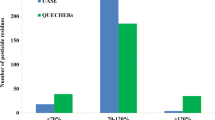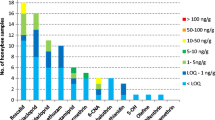Abstract
In the understanding of colony loss phenomena, a worldwide crisis of honeybee colonies which has serious consequences for both apiculture and bee-pollination-dependent farm production, analytical chemistry can play an important role. For instance, rapid and accurate analytical procedures are currently required to better assess the effects of neonicotinoid insecticides on honeybee health. Since their introduction in agriculture, neonicotinoid insecticides have been blamed for being highly toxic to honeybees, possibly at the nanogram per bee level or lower. As a consequence, most of the analytical methods recently optimized have focused on the analysis of ultratraces of neonicotinoids using liquid chromatography–mass spectrometry techniques to study the effects of sublethal doses. However, recent evidences on two novel routes—seedling guttations and seed coating particulate, both associated with corn crops—that may expose honeybees to huge amounts of neonicotinoids in the field, with instantly lethal effects, suggest that selected procedures need optimizing. In the present work, a simplified ultra-high-performance liquid chromatography–diode-array detection method for the determination of neonicotinoids in single bees has been optimized and validated. The method ensures good selectivity, good accuracy, and adequate detection limits, which make it suitable for the purpose, while maintaining its ability to evaluate exposure variability of individual bees. It has been successfully applied to the analysis of bees in free flight over an experimental sowing field, with the bees therefore being exposed to seed coating particulate released by the pneumatic drilling machine.

Similar content being viewed by others
References
Anderson D, East IJ, Cox-Foster D, Conlan S, Holmes EC (2008) Science 319:724–725
van Engelsdorp D, Evans JD, Saegerman C, Mullin C, Haubruge E, Nguyen BK, Frazier M, Frazier J, Cox-Foster D, Chen Y, Underwood R, Tarpy DR, Pettis JS (2009) PLoS One 4:e6481
Ratnieks FLW, Carreck NL (2010) Science 327:152–153
Mullin CA, Frazier M, Frazier JL, Ashcraft S, Simonds R, van Engelsdorp D, Pettis JS (2010) PLoS One 5:1–19
Hopwood J, Vaughan M, Shepherd M, Biddinger D, Mader E, Hoffman Black S, Mazzacano C (2012) Are neonicotinoids killing bees? http://www.xerces.org/neonicotinoids-and-bees/. Accessed Mar 2012
Girolami V, Mazzon L, Squartini A, Mori N, Marzaro M, Di Bernardo A, Greatti M, Giorio C, Tapparo A (2009) J Econ Entomol 102:1808–1815
Tremolada P, Mazzoleni M, Saliu F, Colombo M, Vighi M (2010) Bull Environ Contam Toxicol 85:229–234
Decourtye A, Devillers J (2010) Adv Exp Med Biol 683:85–95
Blacquière T, Smagghe G, van Gestel CAM, Mommaerts V (2012) Ecotoxicology 21:973–992
Henry M, Beguin M, Requier F, Rollin O, Odoux J-F, Aupinel P, Aptel J, Tchamitchian S, Decourtye A (2012) Science 336:348–350
Tapparo A, Marton D, Giorio C, Zanella A, Soldà L, Marzaro M, Vivan L, Girolami V (2012) Environ Sci Technol 46:2592–2599
Krupke CH, Hunt GJ, Eitzer BD, Andino G, Given K (2012) PLoS One 7:e29268
Cresswell JE, Desneux N, van Engelsdorp D (2012) Pest Manag Sci 68:819–827
Wu JY, Anelli CM, Sheppard WS (2011) PLoS One 6(2):e14720
Whitehorn PR, O’Connor S, Wackers FL, Goulson D (2012) Science 336:351–352
Yang EC, Chuang YC, Chen YL, Chang LH (2008) J Econ Entomol 101:1743–1748
Cresswell JE (2011) Ecotoxicology 20:149–157
Schneider CW, Tautz J, Grünewald B, Fuchs S (2012) PLoS One 7:e30023
Eiri DM, Nieh JC (2012) J Exp Biol 215:2022–2029
Greatti M, Sabatini AG, Barbattini R, Rossi S, Stravisi A (2003) Bull Insectol 56:69–72
Marzaro M, Vivan L, Targa A, Mazzon L, Mori N, Greatti M, Petrucco Toffolo E, Di Bernardo A, Giorio C, Marton D, Tapparo A, Girolami V (2011) Bull Insectol 64:119–126
Greatti M, Barbattini R, Stravisi A, Sabatini AG, Rossi S (2006) Bull Insectol 59:99–103
Maini S, Medrzycki P, Porrini C (2010) Bull Insectol 63:153–160
Tapparo A, Giorio C, Marzaro M, Marton D, Soldà L, Girolami V (2011) J Environ Monit 13:1564–1568
Girolami V, Marzaro M, Vivan L, Mazzon L, Greatti M, Giorio C, Marton D, Tapparo A (2012) J Appl Entomol 136:17–26
Girolami V, Marzaro M, Vivan L, Mazzon L, Giorio C, Marton D, Tapparo A (2012) J Appl Entomol. doi:10.1111/j.1439-0418.2012.01718.x
Rancan M, Rossi S, Sabatini AG (2006) J Chromatogr A 1123:60–65
Rancan M, Sabatini AG, Achilli G, Galletti GC (2006) Anal Chim Acta 555:20–24
Seccia S, Fidente P, Montesano D, Morrica P (2008) J Chromatogr A 1214:115–120
Rossi S, Sabatini AG, Cenciarini R, Ghini S, Girotti S (2005) Chromatographia 61:189–195
Gil García MD, Martínez Galera M, Santiago Valverde R, Galanti A, Girotti S (2007) J Chromatogr A 1147:17–23
Totti S, Fernández M, Ghini S, Picó Y, Fini F, Mañes J, Girotti S (2006) Talanta 69:724–729
Kamel A (2010) J Agric Food Chem 58:5926–5931
Martel AC, Lair C (2011) Int J Environ Anal Chem 91:978–988
Wiest L, Bulete A, Giroud B, Fratta C, Amic S, Lambert O, Pouliquen H, Arnaudguilhem C (2011) J Chromatogr A 1218:5743–5756
Fidente P, Seccia S, Vanni F, Morrica P (2005) J Chromatogr A 1094:175–178
Tanner G, Czerwenka C (2011) J Agric Food Chem 59:12271–12277
Di Muccio A, Fidente P, Attard Barbini D, Dommarco R, Seccia S, Morrica P (2006) J Chromatogr A 1108:1–6
Watanabe E, Baba K, Eun H (2007) J Agric Food Chem 55:3798–3804
Angioni A, Porcu L, Pirisi F (2011) J Agric Food Chem 59:11359–11366
Zywitz D, Anastassiades M, Scherbaum E (2003) Dtsch Lebensm Rundsch 99:188–196
Kamel A, Qian YR, Kolbe E, Stafford CJ (2010) J AOAC Int 93:389–399
Zhang FZ, Li YJ, Yu CS, Pan CP (2012) Bull Environ Contam Toxicol 88:885–890
Lee SJ, Park S, Choi JY, Shim JH, Shin EH, Choi JH, Kim ST, Abd El-Aty AM, Jin JS, Bae DW, Shin SC (2009) Biomed Chromatogr 23:719–731
Ferrer I, Thurmanb EM (2007) J Chromatogr A 1175:24–37
Wu QH, Li Z, Wang C, Wu CX, Wang WN, Wang Z (2011) Food Anal Methods 4:559–566
Wang P, Yang X, Wang J, Cui J, Dong AJ, Zhao HT, Zhang LW, Wang ZY, Xu RB, Li WJ, Zhang YC, Zhang H, Jing J (2012) Food Chem 134:1691–1698
Watanabe E (2011) In: Perveen F (ed) Insecticides—advances in integrated pest management. InTech, Rijeka
Anastassiades M, Lehotay SJ, Stajnbaher D, Schenck FJ (2003) J AOAC Int 86:412–431
Ford KA, Casida JE (2006) Chem Res Toxicol 19:1549–1556
Lehotay SJ (2007) J AOAC Int 90:485–520
Currie LA (1999) Anal Chim Acta 391:105–126
Bortolotti L, Sabatini AG, Multinelli F, Astuti M, Lavazza A, Piro R, Tesoriero D, Medrzycki P, Sgolastra F, Porrini C (2009) Julius Kuhn Arch 423:148–151
Iwasa T, Motoyama N, Ambrose JT, Roe RM (2004) Crop Prot 23:371–378
Suchail S, Debrauwer L, Belzunces LP (2004) Pest Manag Sci 60:291–296
Acknowledgments
This work was partially supported by the University of Padova within the PRAT project “Chemical basis of honey bee collapse” and the Ministero delle Politiche Agricole Alimentari e Forestali (MiPAAF), Italy, within the project APENET coordinated by Consiglio per la Ricerca e la Sperimentazione in Agricoltura (CRA). We are grateful to M.T. Musacchio (University of Padova) for helpful revision of the manuscript.
Author information
Authors and Affiliations
Corresponding author
Additional information
Published in the special issue Analytical Science in Italy with guest editor Aldo Roda.
Electronic supplementary material
Below is the link to the electronic supplementary material.
ESM 1
(PDF 301 kb)
Rights and permissions
About this article
Cite this article
Tapparo, A., Giorio, C., Soldà, L. et al. UHPLC-DAD method for the determination of neonicotinoid insecticides in single bees and its relevance in honeybee colony loss investigations. Anal Bioanal Chem 405, 1007–1014 (2013). https://doi.org/10.1007/s00216-012-6338-3
Received:
Revised:
Accepted:
Published:
Issue Date:
DOI: https://doi.org/10.1007/s00216-012-6338-3




